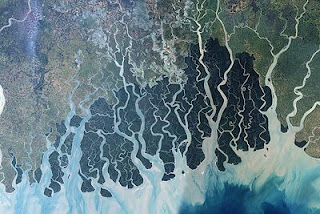When I was a child, my grandfather
told stories of what happened to naughty children. “A great big hoot owl will swoop down from
the top of the big old pine tree, and he’ll snatch you up in his great claws
and carry you way up to his nest at the top of the tree. He’ll settle you down next to all the other
lil’ baby hoot owls and feed you worms.
And we’ll never find you, ‘cause you can scream and scream but that ol’
hoot owl will just think you’re hungry, and keep fillin’ your beak with worms
‘til one day, you’ll turn into a hoot owl.”
This story was immeasurably improved by his raspy delivery on the porch at
nighttime, creaking in the metal rocker.
We were protected from this fate, and by all of the unknown creatures of
the Mississippi
nightwoods, by only a thin mesh of wire screening, a few sticks of wood
frame. It gave my little sister and I
chills, and while we visited, we were very, very good.
The terrors of being left outside
at night were real to us, having experienced the feeling, although often at
close range to safety. But not many
children today get as close to nature as we did in those southern summers,
playing in the barn, the lake, the field; only excluded from the limits of my
grandmother’s garden. Children certainly
aren’t permitted out alone, at night, beyond the safety of their backyard, if
even there. The majority of children are supervised when they play; 52% are supervised even in
the garden. In natural places, this rises to over 80%, even in daytime.
The forest we feared gave us
turpentine, lumber, and paper. It also
gave my grandfather and uncles a living, with jobs in the sawmill,
construction, boatbuilding, farming and timber; it bestowed a subsistence
through deer and turkey and pecans in the fall, figs and berries in the summer,
and firewood all year round. Fear of the
forest recedes with familiarity, but this also inspires new concerns for what
may be lost with the forest: for children, this includes a sense of capability
and independence. For medicine, the
possibility of new cures from endangered species, and a weapon in the fight
against obesity and diabetes. For
ecological balance, the essential predators and top-level species that check
the population of prey and invasive species that can explode without their
vigilance. And for the climate, the
carbon sequestration that is necessary to mitigate climate change.
To suggest that architecture has a
role in encouraging people to spend more time outdoors seems
counterintuitive. And yet, good design
can encourage interaction between inside and outside. A trellis brings nature close for sensory
pleasure; a glasshouse is one step toward a garden; a window an invitation to
step beyond the frame. Without
architecture, the “great outdoors” becomes a threat. In cooperation, the outside becomes a respite, a
relief necessary for our mental health and regeneration.
What time is spent indoors should also
promote health. In the United States ,
this is 87% of our lives – about 69% within our residences, and 18% in work,
school, or leisure. Statistics in other
countries are not wildly different. With
such a radical inversion in the location of human activity over the last two
centuries, indoor air quality becomes much more important. Architecture continues to pursue improvements
such as reducing volatile organic compounds, and improving particle filtration,
so as to reduce allergies and asthma for occupants.
Without nature, the real and
unexpected, the living and unpredictable, shall we enjoy only conservatories
filled with artifice, and survive like the characters of science fiction, with our
only nature a covered roof garden populated with mechanized animals? Architecture
preserves natural habitats through wise resource use, reclamation, rapidly
renewable materials, and efficient structures.
And if, as work and school and media become less aligned with the
circadian rhythms as also predicted in sci-fi, the artifice of aural and
visual stimulation will do little to fulfill our sensory needs. Nature, even at nighttime, supplies the
experience of wind, the sounds of water’s movement, the call of birds and the
rustle of leaves.
As cities become more dense, wild
lands must be preserved through conservation.
Increasingly small patches of nature must rally to fight air pollution,
and promote exercise, to counteract obesity and diseases such as diabetes. The result of access to nature is not only
the restoration of nature, but a human renaissance as well.
As schools become more protective
of their students, will children forever lose recess outdoors, and be confined
to gymnasia and lunch halls? If lessons
from the best school system in the world are taken to heart, the answer will be
a resounding “No.” Finland has the
fewest class hours of any educational system in the developed world, yet
maintains the highest scores in science and reading. Elementary students get 75 minutes of recess
each day, compared to 27 minutes in the United States . A reporter for The New Republic writes, “While observing recess outside the Kallahti Comprehensive
School on the eastern edge of Helsinki
In
rain and sunshine, nature provides essential human needs; in cold and wind it
challenges our survival. Architecture
developed strategies to resist these threats, perhaps too well. Now, the challenge is to create buildings
without air infiltration which invite the breezes, structures immobile against
floods which can later be moved to safer elevations, spaces immune to the sun’s
daily heat gain but retain views of nature and the city surrounding us. Nature deficit is not limited to the Western
World, and is even noted in cities such as Addis Ababa , Ethiopia












.jpg)


